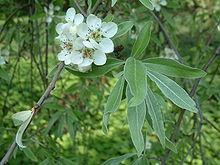Pyrus salicifolia is a species of pear, native to the Middle East. It is widely grown as an ornamental tree, almost always as a pendulous (or "weeping") cultivar, and is called by various common names, including willow-leaved pear,[2] weeping pear, and similar. The tree is deciduous and of comparatively small stature, rarely reaching 10–12 meters in height. The crown is rounded. It has pendulous, silvery foliage, superficially similar to a weeping willow. The flowers are large and pure white highlighted with black-tipped stamens although the buds are tipped with red. The small green fruits are inedible, being hard and astringent.[citation needed]
| Pyrus salicifolia | |
|---|---|

| |
| Scientific classification | |
| Kingdom: | Plantae |
| Clade: | Tracheophytes |
| Clade: | Angiosperms |
| Clade: | Eudicots |
| Clade: | Rosids |
| Order: | Rosales |
| Family: | Rosaceae |
| Genus: | Pyrus |
| Species: | P. salicifolia
|
| Binomial name | |
| Pyrus salicifolia | |
This tree is cultivated widely in gardens and landscapes. It grows well on infertile sandy soils due to its spreading root system. The trees flower in the spring, but during the rest of the year can be trimmed back and shaped almost like topiary. This species of tree is very susceptible to fireblight, a bacterial pathogen.[citation needed]
Pyrus salicifolia may also be confused with Pyrus nivalis which is generally taller and hardly pendulous or with Pyrus elaeagnifolia which has broader entire leaves and longer petioles.[citation needed]
The cultivar 'Pendula' has gained the Royal Horticultural Society's Award of Garden Merit.[3][4]
References edit
- ^ Güner, A.; Zielinski, J. (1998). "Pyrus salicifolia". IUCN Red List of Threatened Species. 1998: e.T34721A9885399. doi:10.2305/IUCN.UK.1998.RLTS.T34721A9885399.en. Retrieved 12 November 2021.
- ^ BSBI List 2007 (xls). Botanical Society of Britain and Ireland. Archived from the original (xls) on 2015-06-26. Retrieved 2014-10-17.
- ^ "RHS Plant Selector - Pyrus salicifolia 'Pendula'". Retrieved 30 May 2013.
- ^ "AGM Plants - Ornamental" (PDF). Royal Horticultural Society. July 2017. p. 83. Retrieved 23 September 2018.
External links edit
- Media related to Pyrus salicifolia at Wikimedia Commons
- "Pyrus salicifolia". Plants for a Future.
- Pyrus salicifolia in the CalPhotos photo database, University of California, Berkeley
